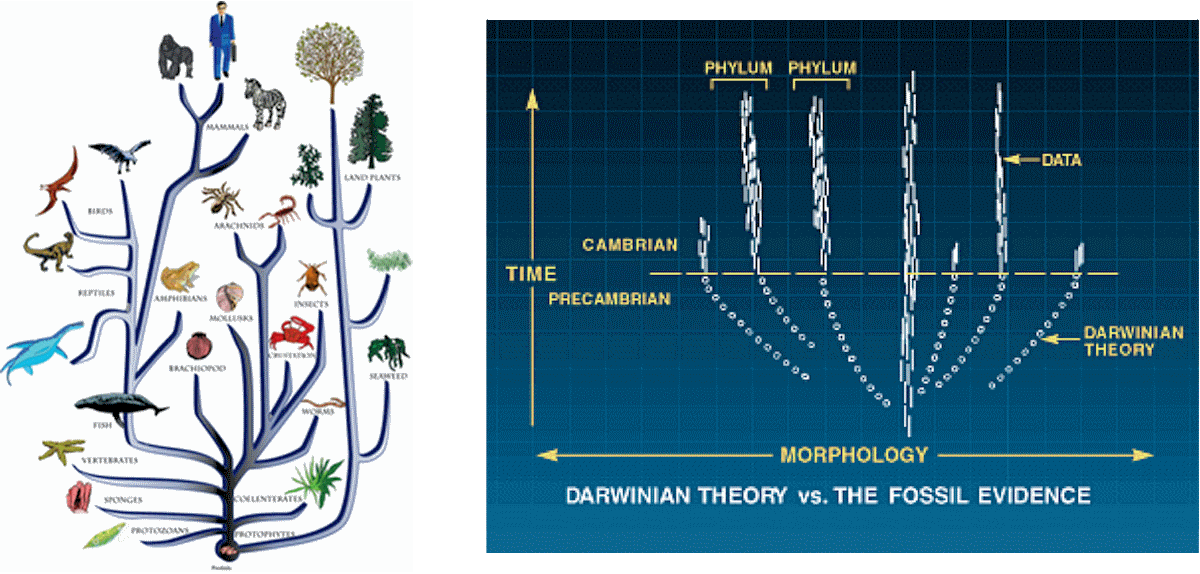
Selvopdagelse
Det første princip er at hjælpe deltagerne med at finde frem til beviser for design selv. Denne tilgang er især vigtig for mennesker, der har været socialt betinget til at undertrykke ethvert tegn på design i naturen, som de møder. Processen med selvopdagelse kan omgå implanterede forudindtagelser og mentale barrierer, så sandheden fuldt ud kan engagere sindet.
En af mine yndlingsøvelser er at vise en række objekter eller mønstre og bede lytterne om at tildele en score fra 1 til 10 for deres tillid til, om et billede er designet versus blot et produkt af naturlige processer og tilfældighed. En score på 1 svarer til fuldstændig tillid til manglende design, og en score på 10 svarer til fuldstændig tillid til design. Jeg har ofte publikum, når jeg tæller op fra 1 til 10. Når deltagerne hører antallet svarende til deres score, sætter de sig ned. Jeg bruger bevidst nogle billeder, der er meget tvetydige, og jeg slutter med et objekt eller mønster, der er tydeligt designet, såsom Mount Rushmore eller et styrtet rumskib.
Kommentar: Delvist oversat af Sott.net fra How best to teach young people to discover the evidence for design in nature See også link og kommentarer sidst i artiklen.

- Improbability of the object forming by chance.
- Differences between the object and the surrounding environment.
- Inability of natural process to generate the pattern.
- Similarities between the object and other known objects or patterns, such as between the faces on Mount Rushmore and pictures of famous Presidents.
- Evidence of purposeful intent.
Animations
The final stage in the design detection exercise is to show an animation of some molecular machine such as ATP synthase. I then ask participants to assess whether the object is the product of natural processes and chance or the product of intelligent design based on the criteria they just identified. After participants choose design, I ask what led to their conclusion. The answers are always the same as for the obviously designed object in the first part of the exercise. In the end, participants never forget why the conclusion of design in life is self-evident.
In general, animations are one of the most effective tools to demonstrate the evidence for design in biological systems. Imagery speaks simultaneously to the mind and to the emotions. Animations also convey vast amounts of information in a short span of time. And, they become fixed in the memory far easier than mere prose. Today, several animations are readily available that demonstrate the wondrous engineering in life. Here are but a few examples:
Analogies with Images
Another effective technique is to use simple analogies illustrated by memorable images. One of my favorite examples relates to the information in DNA or in the amino acid sequences comprising proteins. To demonstrate how information points to design, I ask listeners to imagine having the flu and being called to the kitchen by ones mother for lunch. I continue by describing a bowl of alphabet soup sitting on a table. At the same time, I show a picture of the soup with the letters forming the message "DRINK PLENTY OF FLUIDS AND REST UNTIL YOU ARE FEELING BETTER." I then explain how a short word might form by chance, but such a long message could never be explained by chance or any natural process such as the chemistry of the pasta or the physics of the heated broth. Large quantities of information can only be generated by a mind. And that conclusion is not simply falling into the concerned-parent-of-the-gaps fallacy. This illustration conveys how information reliably points to design far more easily than deconstructing all of the junk science floating around the Internet claiming that natural processes can generate large quantities of information for free (see here, here, and here).
Another helpful illustration is showing the predicted evolutionary tree of life next to the actual data from the fossil record corresponding to the Cambrian explosion. The disparity between theory and reality is so stark that most immediately recognize the tension. For instance, I met a student at Charles Darwin University in Darwin, Australia. He told me that he had decided to abandon belief in God because evolution proved that we were simply the product of blind natural processes. I have to admit that for some reason I anticipated his comment. I showed him the two images below. After viewing the images for less than a minute, he said that he recognized that evolution could not be true, and he immediately renounced his atheism.

Implications
I often conclude my presentations by explaining the practical implications of recognizing that we are not the product of blind, undirected forces, but we are the creation of a designer. As an illustration, I ask listeners to imagine finding a rock on the beach. That rock most likely did not come with a manual that instructs readers to place the rock in a slingshot, pull back the rubber band, and then release. Since the rock was not designed, it has no particular purpose. In contrast, if one finds a watch, one immediately recognizes that the watch was designed, so it should be used according to the intentions of its maker. If one instead uses it to hammer a nail or to stir a cup of coffee, its potential and value would be diminished.
In the same way, people who believe they are simply an accident of nature have no reason to believe that they have any intrinsic value or worth, that objective morality exists, or that they can live for any meaningful purpose. In contrast, those who recognize that we were designed understand that we have inherent value, we should live by a moral standard corresponding to our design parameters, and our lives have inherent meaning and purpose. I might also show images of a rock and a watch to reinforce this crucial lesson.




Kommentar: See also the five part presentation in slow, clearly spoken English by Michael Behe.Total duration is about 30 minutes.
(Ep 1) Darwin Day: Discovery Institute's Video series "Secrets of the Cell with Michael Behe"
(Ep 2) 40 Trillion cells in your body and each poses a mystery! Part II of "Secrets of the Cell with Michael Behe"
(Ep 3) In episode 3 of Secrets of the Cell, Michael Behe tests "the power of evolution"
(Ep 4) Episode 4 of 'Secrets of the Cell': Broken wolves and other evolutionary conundrums
(Ep 5) The X Factor in Life (Secrets of the Cell with Michael Behe, Ep 5)
Denne er mere avanceret, men sætter Behe's indsigt i perspektiv: New research finds molecular machines are even more amazing than Behe realized
I praktisk undervisning i Danmark er den officielle tilgang til design i naturen i Grundskolen fremlagt i Fælles Mål for naturfagene.og Naturvidenskabens ABC Se Erkendelse 5 Alt liv har udviklet sig gennem evolution. Det vil sige, at tegnene på design i naturen fortolkes som tegn på spontan evolution nogle milliarder år efter Big Bang. Det forhindrer ikke elever og lærere i at lade sig indformere om andre muligheder. Det er op til dem at vælge, hvilke argumenter, der er bedst, men i eksamenssituationer kan der opstå et dilemma, som man må være forberedt på at håndtere på en oplyst og strategisk måde.